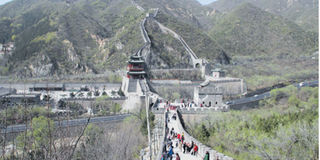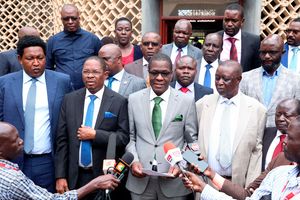Where tradition and modernity exist in harmony

Tourists strolling on the Great Wall, which is perhaps China’s best known feature. PHOTO | AGGREY MUTAMBO
What you need to know:
- Although the government still has great control over what goes on in the country, China has modernised rapidly from a communist state, boasting hundreds of millionaires and now the world’s second largest economy.
- In Beijing, he said, it is sometimes cheaper to buy a car than to get a number plate for it. Thanks to pollution — the price the country is paying for rapid industrialisation — the authorities discourage the use of motor vehicles. So number plates are released only rarely, and at public auctions so folks jostle for them, pushing the price to prohibitive levels.
- But despite Beijing’s rapid transformation, many people still use bicycles, whose use the government encourages; it has built cycling lanes in the busy city. Paradoxically, while you’re stuck in traffic, they zoom past, enjoying themselves.
Arriving in the world’s most populous country makes you feel as if a huge, blank canvas has been unrolled before you on which to paint a lifetime picture in your memory.
China boasts a number of natural features including mountains, lakes, deserts and forests, as well as pandas and the Great Wall. It also has glittering skyscrapers in the cities, a rich cultural heritage, good food and beautiful women – always on the go.
Modernity and tradition are inextricably interwoven. The taxi driver at the Beijing Capital International Airport, Xiao Ying, alias Paul, spoke no English, but had a smartphone. The Chinese know that few foreigners can remember their names, so they often introduce themselves by their Western nicknames.
After exchanging a few non-verbal pleasantries we were soon on the highway heading southwards out of the airport. It was early morning, so the traffic was bearable. Sometimes we could speed along, at other’s we would be moving at a snail’s pace.
But every time we stopped, Paul would whip out his smartphone — the latest iPhone 6 — for a selfie here, a quick update on WeChat there, or to check the weather report.
Chinese traffic police are strict and will occasionally pull over wayward drivers caught chatting on the phone or making wrong turns. But the drivers can’t resist sneaking a glance at their phones every time they come to a red traffic light.
The journey to the hotel took us an hour instead of 20 minutes because “too much cars was slowing us,” Paul informed us via a translator app on his phone. “We move fast all other days, but we move slow today,” he explained.
In Beijing, he said, it is sometimes cheaper to buy a car than to get a number plate for it. Thanks to pollution — the price the country is paying for rapid industrialisation — the authorities discourage the use of motor vehicles.
So number plates are released only rarely, and at public auctions so folks jostle for them, pushing the price to prohibitive levels.
MIDDLE CLASS TRENDS
But despite Beijing’s rapid transformation, many people still use bicycles, whose use the government encourages; it has built cycling lanes in the busy city. Paradoxically, while you’re stuck in traffic, they zoom past, enjoying themselves.
From the airport, we passed by a public park where several couples were taking photos in wedding attire. Weddings are big occasions in China, we later learn from our host, Wang Shuo, aka Kevin, of the China Research Institute for Press, Radio, Film and Television.
Couples simply notify the magistrate and then proceed with the wedding plans. But before the big day, they have a professional photo-shoot. So you will see couples taking photos at public parks, by the road, on bicycles, or even at the museum.
What if someone bolts before the big day?

Engaged couples take photos in their wedding outfits at a public square before the big day. PHOTO | COURTESY
“In Chinese culture, trust is very important,” Kevin explained over hot pepper soup with noodles and Beijing duck. “By going to notify the magistrate, you show total commitment. So people don’t change their minds.”
Otherwise, Chinese weddings are similar to Kenyan ones, with plenty of food: rice, potatoes, beef, duck, pork and noodles, all eaten with chopsticks.
Notable the reports and discussions in the media tell of a country that is dealing with middle-class trends.
That morning’s newspapers carried reports of events that had caused a furor on social media, as well as the latest craze among modern Chinese women. The People’s Daily carried a story about a woman who had been attacked in a hotel by a male guest.
The public demanded that the man, who was in police custody, be punished after a video was shared on Weibo, China’s version of Twitter. Foreigners only knew about the incident after it was aired on CCTV English channels.
But even more fascinating were fashion commentators: “For a perfect woman’s body, there seems to be a new ‘standard’: iPhone 6 legs and 100-yuan wrists,” declared an article in the China Daily, the main English-language paper in Beijing. It was about the latest slimness trend among women. So having iPhone-6 legs means the 13.8cm phone can cover both knees when placed horizontally on them.
The article went on to say how women measure their slimness by wrapping a 100-yuan note around their wrists; if it doesn’t enclose the whole wrist, you need to work on your weight. In a way, this fad depicts the freedom of consumption in China.
Chinese women research online about what the article called bizarre standards, to determine smallness, ranging from wrapping your hand around your waist to tucking a pencil beneath your breasts.
There is a reason why the Chinese worry more about appearance than poverty than they did in the past. China, now considered the world’s second largest economy, boasts 596 billionaires, about 60 more than the US, despite the recent stagnation of the country’s economy. About 80 of them live in Beijing, and some of them were born in the ’80s, according to a recent survey, The Harun Report.
The report, released by the Hurun Research Institute in Shanghai late last year, said 242 Chinese became billionaires in just one year.
Although Bill Gates remains the world’s wealthiest man, China’s richest billionaires employ about 10 million people and are investors in the media and entertainment (Wang Jianlin of AMC Cinemas), e-commerce (Jack Ma of online shopping platform Alibaba) and IT services (such as Cheng Wei, who created a local taxi app).
Others, come from manufacturing, the motor vehicle, pharmaceutical and real estate industries, with a combined wealth of $2.1 trillion, more than the GDP of countries like India and Russia.
MODERATE PROSPERITY

The Beijing National Stadium, also known as the Bird’s Nest, is an architectural marvel and one of China’s modern buildings. PHOTO | COURTESY
Last year these individuals paid tax worth $100 billion, equivalent Kenya’s annual budget for five years. With this kind of money, it is easy to see why fashion, body size and smartphone can be an obsession.
Yet what you see in public is half the story. China and Beijing never used to be like this. In fact, for a long time the Chinese capital was Nanjing in the south.
Then, in 1949, the Mao Tse Tung-led revolution proclaimed what is today known as the People’s Republic of China.
Its population was 500,000,000, according to estimates published in Foreign Affairs at the time.
But that population largely comprised poor, hungry peasants and illiterate or semi-skilled workers. The communist revolution sought to bridge the gap between the peasants, workers and the bourgeoisie.
That marked the beginning of the move to today’s vibrant economy even though historians agree that China had no one to learn from, given that it was such a closed society.
“It was just about wading across the river by feeling out stones,” recalls Zhang Baija, a professor of history at China’s prestigious Peking University.
Chairman Mao, as he is fondly referred to, created a totalitarian regime in which the state had a tight grip on every aspect of life.
It is even said that Chinese workers had to seek their bosses’ permission to bring their wives or concubines to their quarters, or even to marry.
If your boss denied you permission, that would be it, a professor of communications told a gathering of African journalists in Beijing.
Mao created a structure that kept a finger on the pulse of people’s private life. But it is a system the country still uses – a chain of bureaucratic units and personnel capable of amassing resources for the public good.
When Mao died in 1979, there were changes, according to Zhang, who has written a book on Chinese economic reforms.
The country started abandoning the old economic system and advocating for an inflexible model of centrally planned policies and imposing them. With time, state enterprises keen on making profits emerged to compete with private companies.
The concept, which came to be known as moderate prosperity, noted Zhang, was based on the understanding of the Chinese public as a “social situation characterised by not worrying about clothes and food, domestic peace, the top and down in perfect order and the fastidious observation of etiquette.”
The man credited with that was Deng Xiaoping, a revolutionary and paramount leader between 1978 and 1989.
Nearly 40 years after Mao’s death, the Communist Party followed up with reforms that opened up China as the biggest manufacturer and consumer of cars, clothes, property, stock exchange and even latest technological devices.
But the freedom of consumption has not necessarily translated to freedom, as understood in the West. Here, some websites are routinely blocked and free speech in the Western sense does not exist.
“The government acts like the grandpa; it decides which computer games, social media and movies to access. It provides everything but it also makes rules for the family (civilians),” said Mr Zeng Qingjun, the vice manager of China Network Broadcasting Company.
“This is Chinese culture and sometimes the Western world does not understand it.”

The Najing Quinhai River. Before the Mao Tse-Tung led revolution in 1949, Nanjing in the country’s south was the capital city. PHOTO | AGGREY MUTAMBO
_____
KENYAN LINK
Nanjing and Malindi, an ancient connection
There was once a Chinese explorer called Zheng He who, according to legend, set sail rom Nanjing city in southern China for the West between 1405 and 1433.
He travelled to 30 countries and arrived at the Kenyan coast on his fourth voyage between 1413 and 1415. In Malindi and adjacent areas, it is said that the Chinese explorers accompanying Zheng escaped a shipwreck and were integrated into a local community, where they converted to Islam and intermarried.
On the 600th anniversary of that voyage, the Chinese tried to follow up the story, taking DNA samples from a family thought to have descendants of the explorer near Lamu. The Chinese government subsequently gave a full university scholarship to a woman identified as Mwanamaka Sharifu, who is believed to be a direct descendant of Chinese sailors.
The Chinese have been trying to retrace Zheng’s voyages in what they now call the Silk Road, a connection between the countries he visited, but which is aimed at linking them with China for trade.
Nanjing, China’s ancient capital during the Ming Dynasty, sometimes known as the City of Emperors, is considered a link point because it lies in the middle of the Yangze River, which runs from west to east, with a coastline covering the same distance from Nairobi to Eldoret.
The Chinese recently created a 125-metre deep waterway extension to the city, enabling it to handle vessels of up to 50,000 tonnes, though larger vessels can come in using the sea tide.
The port itself serves as a convergence point between the river and the east coast, and handles an annual cargo of 200 million tonnes, nine times what Mombasa handles.
But a tour of Nanjing reveals it has held on its beauty and heritage as it hosts the Tianfei Palace, the Jianghai temple, Zheng He’s shipyard and tomb, and the tomb of the king of Boni.
The city’s name is a combination of “nan” and “jing”, which in Chinese mean South and Capital respectively.
And unlike other parts of China like Beijing where people traditionally love dumplings and bread, Nanjingers like roast duck and rice. On the main streets, you can find smoked, salted duck on wooden skewers by the fireside. They are also sold in some supermarkets.
Today, 8 million people live in the cityand trade with the outside world reached $6.62 billion in 2014, according to the municipal authorities.





